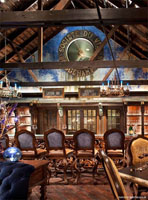
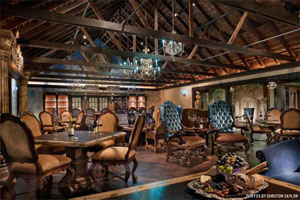
The Opulent Hollywood- style Set of Societe du Vin

This year has certainly seen its share of great tastings, and while the ‘Tasting of the Year’ took me three articles and over three months to write up, it was arguably dethroned rather quickly by the greatest Petrus tasting of all-time. Fifty-seven vintages (all from the same collection and traceable back to Petrus itself with their special, individual owc’s) were opened by and at Societe du Vin, a private members-only wine facility located in Bridgehampton, NY, specializing in wine storage and designed by Hollywood Set-Director, Elvis Restaino. The goal was to create an environment where members can store their wine and enjoy it in the attached tasting lounge while engaging in a community of wine enthusiasts. Société du Vin plans to host several tastings throughout the summer months but will be open almost year-round for members to enjoy the space. It is a beautiful and unique space, and we look forward to hosting our next Hamptons auction there in June.
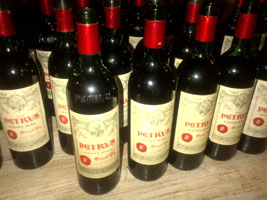
Piles of Petrus
The weekend was moderated by James Suckling, and also attended by The Hedonist, so including myself, there were three writers on the scene for this legendary event. The first half began on Friday night, and James warmed us up with a few tidbits, noting how America was really the country that made Petrus famous in the ’80s and ’90s, and that it was over twenty years (1991) since he had done a Petrus tasting that had even come close to what we were about to experience. Today, Oliver Berrouet is in charge of the winemaking duties at Petrus, following in the footsteps of his father, Jean-Claude. The production now averages about 2500 cases, although it was even less in the distant past. Speaking of averages, Petrus is 95% Merlot and 5% Cabernet Franc, and its vines are 100% grown in clay soil. With fifty-seven vintages to sample, that was all the information we needed, and we were all thirsting for our first sip of Bordeaux’s most collectible and expensive wine.

Moderator Extraordinaire
Friday night’s session had us in the modern-era, ie 1982 and younger, and we began with a flight of ‘lesser’ vintages. I have always said that great producers make great wines every year; some just don’t age as long as others. The 1997 Petrus had a nice nose with pleasant plum, cocoa and mineral aromas along with touches of olive and saddle, and a pinch of greenness. At age fifteen, the ’97 seemed to be hitting its sweet spot. The palate was lighter than the average Petrus, but it was soft and tasty with cherry flavors. James admired its ‘black olives, meat and chocolate’ and found it almost Burgundian in character. While it didn’t have the richness of a great Petrus, it gained a bit in the glass and was quite pleasing overall (92+).
The 1994 Petrus had a more pungent, meaty nose with lots of iron, iodine and wild red licorice. There were grain and animal flavors and a medicinal kick to its palate, along with nice richness to its fruit. The Hedonist noted, ‘tapenade,’ and there was also instant oatmeal on its finish. The finish was a lot softer than I expected for this tannic vintage (91).
The 1993 Petrus had an earthy and barny nose, also full of minerals. One commented how it was short and drying out, but I thought that was a bit extreme. This was a rough and rugged Petrus ; it definitely had a bite. It didn’t have the table manners that most of its siblings possess, but its wood and heat made it a bit of a badass. Roman admired its ‘raspberry cassis,’ and I still found it to be very good (92).
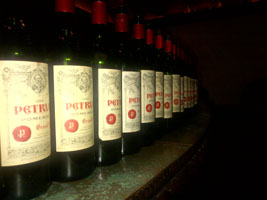
Lineup from the Left
I could not say the same for the 1992 Petrus, one of the weakest wines of the weekend, and certainly of this flight. Its nose was yeasty and earthy with a slice of coconut and some dried fruit, almost apple. The palate was simple and relatively unexciting (88).
If there was one vintage that arguably could have been in another flight, it would have been the 1988 Petrus. The Hedonist joked that this was an ‘English vintage, tight ass.’ Roman observed, ‘hazelnut and almond,’ and I also found exotic qualities of cinnamon and red fruits. It was rich, tasty and had the best acidity of the first flight. Cereal flavors rounded out the palate, which lost a step in the glass in time (93).
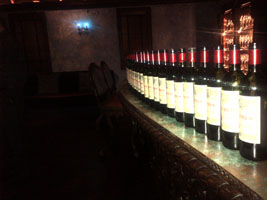
Lineup from the Right
The 1987 Petrus was corked but still decent. There was a bit of bubble gum perfume, game and date to the nose, and a pleasant, cedary palate. It was round and left a positive impression despite its corked handicap (90A).
The second flight began with the 1986 Petrus and a nose full of red cherry fruit with a shot of cough syrup. Its feminine nose also emitted garden, earth and chocolate aromas, and its palate was a touch sweet. The Hedonist found there still to be a lot of tannins left, and its sandpapery finish backed his opinion up. The palate headed in a candied and caramel direction, ‘a little raisiny’ per James, and ‘baked’ per The Hedonist (93).

The Second Flight
The 1985 Petrus was a horse race with the 1986, literally, as horse and animal was the first thing I noticed in its nose. There was also deep forest and noticeable t ‘n a there. The palate was rich with olive and chocolate flavors, along with tangy bing cherry and game. This was still zippy, more so than most ’85s, and it also had some bakery sweet bread flavors develop. There was a sweatiness that stayed with the 1985, and I preferred it ever so slightly to the 1986 (93+).
The 1984 Petrus had seashells and sawdust in its nose, and while there was not a lot of fruit, it wasn’t bad for 1984. There were flavors of plum and cereal, along with baked apple pie. There was just enough light grit to make it pleasant from start to finish in the mouth (90).
The 1983 Petrus smelled like good real estate in the nose. There were also musk, oats and chocolate pie aromas. The palate was in a great spot like many 1983s, still not peaking either. Rich, tasty and long, I thought this was the best wine of the evening so far, although The Hedonist found it a touch dry (94).
We had another slightly corked wine, this one being the 1981 Petrus. Again, oatmeal and cereal were in the nose, but it was tough to get to much more than that with the TCA there. The palate, however, showed less of the corked qualities, and it came across with impressive earth, meat and black fruit flavors. There was nice flesh to this tasty wine, which was even one’s favorite of the flight (92A).
The crowd was split about what was the wine of the flight, and the 1980 Petrus made an unexpected claim for that title. This was a party Petrus with its wild nose, which was dominated by green olives. There was this Burgundian wildness here, and ‘layers of flavors’ per The Mogul. The palate was lush and tasty, another vintage in a great spot, and certainly the surprise of the night so far (93).

Cork Art
We went forward in time for the next flight, beginning with the youngest wine of the weekend, the 2007 Petrus. This was baby juice by comparison, with grapy, plummy, almost inky fruit that gave a sunny and beachy impression in a California way. The palate was ripe and rich with touches of cinnamon and oatmeal, along with candied fruit and a smooth finish. I wondered whether this wine (and flight in general) reflected that the overall quality of winemaking has gotten better, or just different, and whether that was technology’s blessing, or curse (93).
The 2006 Petrus also had that California exuberance in its rich and buttery nose, along with blueberry and banana fruit. The palate was rich, heavy and large with a creamy, buttery style. Big and buttery appeared in my notes over and over again (95).
I didn’t have much to say about the 2004 Petrus, other than ‘similar candied profile’ and ‘softer.’ It was still an excellent wine, although these young adolescents were starting to be difficult to differentiate as much as the older wines, which is both the worst and best fact about great Bordeaux – it is tough or often a mistake to drink young, but oh so good when old (93).
The last wine of this flight was a 2002 Petrus. This was much leaner in the nose, more cedary and dry. While it didn’t have the fruit profile of the previous three, I liked its poise, strength and character. Its dryness was its strength, for now (93).
I know what you are thinking, sixteen vintages of Petrus and one 95-point wine?!? This Petrus stuff must be overrated and overpriced! Don’t be an uneducated blogger, will ya? There are enough of those out there already, so hold on a second, there was a method to our madness, and might I remind you that Bordeaux really doesn’t get interesting until 1982 and older, as a general (but not universal) rule of thumb.
We marched on to the next flight, which led with the 1999 Petrus. It was as if I was in familiar territory again, back amongst adults after those adolescents from the first decade of the 21st century. Yeast and earth were the first things that stood out of the ’99’s nose, along with t ‘n a and muscular, big and brawny fruit. Black and purple dominated the scenery, although coconut kissed its way in the front door. There was nice game to this zippy, bodybuilder of a Petrus, although The Mogul found it closed (94).
The 1998 Petrus was another monster of a nose, pairing well with the 1999. It was deep like the middle of nowhere in the Pacific, possessing both black fruit and pudding. Its minerals glistened, and smoke and raspberry added complexity. Its palate was a whopper, and while tight, it still showed its big personality well. Flavors of earth, yeast, plum and chocolate were all present, and its acidity lingered in the belly. This was the first, truly profound Petrus of the weekend (96+).
The 1996 Petrus was austere and ‘greeny,’ although there was still yeast and purple rain. While softer and easier than the 1998, it still had some zip. Typical suspects of yeast, smoke, earth, game and chocolate rounded out the palate (92).
The 1995 Petrus was another deep wine, ‘hard’ per Les. The ’95 possessed aromas of yeast and smoke. Muscular and powerful, the 1995 had a boatload of tannins and lots of unrealized potential to follow. I had this another time this year, and it left an even better impression away from all the other Petri dishes, so to speak. Comparative tastings sometimes can lessen or mute a bit the impression one might have when one on one (95+).
There were two flights to go, and this next flight was a championship one, beginning with a glorious 1990 Petrus. This was a fruity and sexy Petrus, a veritable red, black and purple ménage a trois in its tropical nose. Cedar and pomegranate emerged to add secondary complexity. The palate was decadent and tasty; its opulence was spilling out of the glass, but its cedar and structure provided foundation and backbone. There was jam on this toasty, gamy and exciting wine. While 1989 has historically stolen the thunder from the 1990, this was one of the best 1990s I can remember (97).
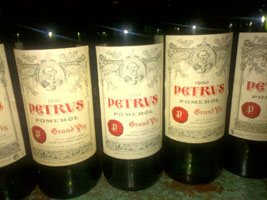
The Flight of Night ONE
Well, the 1989 Petrus did it again. As good as the 1990 was, the 1989 was again better, even though this was more of a photo finish than I remember the other four or five times I have had these wines together. The 1989 had more acidity and zip; it came across broader and deeper, with more earth and length. It wasn’t opulent like the 1990, but its chocolate, yeast, cedar and black fruits were indubitably great. This remains one of the greatest young wines in the world today, and yes, twenty-three years old is young for great wine (98+).
Alexander The Great noted ‘charcuterie’ in the meaty 1982 Petrus. There were lots of green olives as well in this open and gamy Petrus. Someone remarked this was ‘a perfect bottle of 1982,’ and it was similar to the 1980 with its openness. Free love, man, I told you Bordeaux only gets interesting 1982 and older! This was more serious than the ’80, and its palate was lush, tender, soft, delicious and gamy. The Mogul found this was in a ‘sweet spot’ and that ‘it melts in your mouth.’ More olive flavors emerged, and this certainly felt like a great time to be drinking this wine. I still think that while outstanding, it will always be in the second-tier of great Petrus es (95).
There was one more flight to go in our first session, and it was the big-time, young gun flight. I switched it up and went oldest to youngest, since they were all so young, which meant I started with the rock-star 2000 Petrus. I don’t care what everyone says about 2005, 2009, 2010 and the next four vintages of the century that Bordeaux will produce over the next decade, 2000 is still the benchmark vintage for Bordeaux for the 21st Century. The first aroma that assaulted my senses was coffee. The next thing I noticed was its power. The third thing I noticed was how deft and balanced its fruit still was despite all that power. Its fruit was definitely big blue, so much so that I wrote ‘GO GIANTS!’ Yes, it was my 22nd wine, and we all know what happens at this stage of the tasting J. Its nose was ‘perfect,’ and its rich and decadent palate was clearly in the superior category. The Hedonist saw a little ‘baby 1990’ in it. I believe I gave this wine 99 points previously, and I would not be surprised to see other bottles down the road returning to that glory (97+).
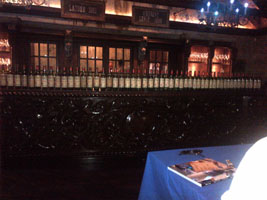
Let’s Put This In Perspective
Next up was the 2001 Petrus, an ‘insider’s secret’ vintage per The Hedonist. There was coffee and chocolate in its nose, along with minerals, wheat and a more seductive power than the 2000. This was sexy, seductive and great, and while my notes were waning, the self-evident pleasure of the 2001 Pomerols were not. I still remember a trip to Bordeaux where either Guideneau or one of the Moueixes told me that they wouldn’t be surprised to see 2001 outshine many 2000s a decade or two down the road. This was a big, deep wine, one that left The Mogul’s mouth ‘still dry thirty seconds later’ (95).
The 2003 Petrus was exotic with its cinnamon and molasses aromas. The palate was beefy, rushy and rich, although I can’t for the life of me figure out what rushy means. It was a bit sweet and over the top, a vintage of Petrus that is probably better being sold than consumed in general (92).
There was one last wine, the 2005 Petrus. While I recognized its greatness, I also wrote, ‘I can’t do it.’ It was too concentrated and young for me at this stage; I had given all of myself to each and every wine up to this point and was officially on empty. ‘Coffee, big and buttery, outstanding for sure’ was about as much as I could muster (96+).
The general consensus was that 1989, 1990 and 2000 were the greatest wines of the night. Twenty-five down, thirty-two to go, and what a thirty-two they would prove to be, although I suppose that it was ultimately closer to a top twenty.
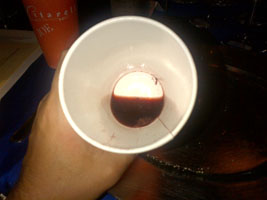
Not Much Spitting
Twelve hours later, we began with the 1977 Petrus and another flight of lesser years, but this time with real age on them. None of them could be good, right? Well, the 1977 was certainly evidence for that argument with its nose of dried-out olives and cobwebs. It was ceramic and stony, although there was a touch of plum there. Its palate was brothy and earthy with ceramic, barn and animal flavors. This was just ‘bones and skeleton’ and overly dry (85).
The 1974 Petrus had a nicer nose and darker fruit, along with lighter chocolate aromas. The palate was clearly better than ’77. It was what I would call ‘decent.’ Soft and tasty, this was pleasant and easy with a touch of cardboard in a good way (88).
The 1973 Petrus had more green olive and veggie in its nose, not in an off-putting way. This was tasty, fleshy and actually ripe with some good tomato flavors. There was a nice mineral complexity to the lightly vimful ’73, which was still in a good spot and one of the sleeper vintages of the entire weekend (91).
The 1972 Petrus had powdered sugar in its nose, along with blacker olives and some tomato. This was very aromatic, but its palate was not as good, possessing little fruit and some dry alley flavors. Someone noted that there was ‘almost carbonation’ here, too (86).
The next two ‘off’ vintages both crossed the 90-point barrier, beginning with the 1969 Petrus, which had an exotic nose. Touches of soap and soup mixed with red dust in its dryish aromatics. It got drier in the nose, and I noted that I overswirled a bit while talking, which is not a good idea with older, lesser vintages, as they will not last longer in the glass, and swirling opens up a wine more. The palate, however, had nice lushness in a round way, blacker flavors and a nice finish with respectable acidity. This was still solid (91).
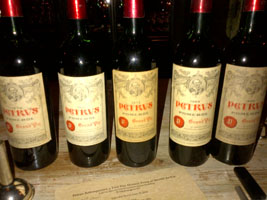
Off Can Sometimes Be On
Last in our first flight was the 1968 Petrus, another wine that exceeded expectations. Roman noted ‘marzipan,’ and James ‘custard.’ It smelled and tasted like a chapitalized Red Burgundy. It was quite gamy with that tobacco and Worcestershire edge. Soft, lush and pleasant, the 1968 was still enjoyable (90).
Our second flight continued with the old and obscure, specifically the 1963 Petrus. Its nose was minty in almost a red way. There were some curds and whey there, along with more red spice. The palate was round and rich but metallic with unripe tannins. There were some pleasant, purple flavors but not much more (89).
The 1960 Petrus was corked, but it could have been a 90-point wine. It was almost bloody in its concentration and felt packed with fruit, ‘very fresh’ per one, but it was ‘hard tasting through’ its corkiness, as James observed (90A+?).
The 1957 Petrus was quite ceramic with lots of band-aids in its nose. The Hedonist found it ‘charred,’ and there were angular aromas of wheat, olives and chocolate. The palate was round and dusty, packed with fruit in a carry-on bag kind of way. Band-aids took over the palate (87).

Hey Buddy! Can You Get Out of My Shot Please?
The 1954 Petrus was about as bad as it got this weekend, with tons of volatile acidity in its nose along with glue. There were bloody mary and celery flavors to this weird wine, which still had decent texture. I wouldn’t call it undrinkable, but it was close, which would mean below 80 points and NR, ie not recommended (82)..
The 1951 Petrus smelled good with nice toast and wheat aromas. Someone remarked, ‘I could drink this,’ a version of a compliment. Its nose was ‘fishy’ to one, but I picked up on cinnamon, dust and dirty birdie. The palate was chocolaty, rich and oily, rather impressive and zippy. It had the most strength of anything so far this afternoon (92).
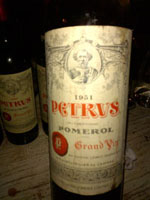
The Likes of Which May Never Be Seen Again
We traveled back to the Seventies with our next two flights, beginning with the 1979 Petrus. Clearly, we were in younger territory, as well as a more serious category of vintage. Its nose was a bit oceanic, and chocolate was there along with tropical purple. While deep and dark, its fruit was ‘deprived and very dry,’ per The Hedonist, and he was right, particularly in the middle and backside of the palate (88).
The 1978 Petrus was mildewy with a touch of cardboard and redder fruits. While its palate was lusher and more purple, the cardboard stayed, although the wine wasn’t corked. While pleasant and ‘more tannic,’ it was ‘long yet flat.’ Rainwater was present on its palate (90).
The 1976 Petrus also had some cardboard without being corked, and it was minerally, dusty and zippy. It was broad-shouldered with its black fruits in the nose, and deep with its purple fruit on the palate. It was a big wine, and surprisingly the best of the trio we just sampled (92).
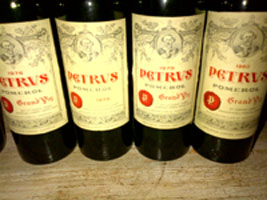
The Redheads of Petrus
The 1975 Petrus just slaughtered everything so far on this afternoon. We were clearly in a different, and much better, category of wine, with tons of breed. While a touch shy, there were fresh garden aromas and a deep, seductive minerality here. The palate was rich and decadent, and its acidity stellar. Brooding, big and classic, this was a beautiful monster, one whose acidity kept getting noticed more with each sip. James admired its ‘rough velvet.’ Despite this being a big and monstrous Petrus, the wine still had a delicacy that tickled me. It had a tight and taut personality like a good corset, and it rolled off my tongue like words in a good book (96+).
Unfortunately, the 1971 Petrus was completely (DQ). It was corked beyond repair, unnatural selection at its worst. All things considered, no one could complain given the condition of this collection so far.
The 1970 Petrus was another great Petrus. The 1975 and 1970 are probably the two best values for great Petrus in the market today. It blows my mind when people pay the same price for 2006 etc, as they do for these vintages. Hellllooooooooooo! The 1970 was stony and muscular, with a broader palate and noticeably more oak, but not in a bad way. The Hedonist admired its ‘great purity and definition.’ I was loving this wine, another beautiful monster that was big and rich, a wine that got bigger and more massive with each sip (97).

Anaconda!
The last wine of this flight segued to the Sixties, that being a 1966 Petrus. There was more menthol to its fruit, and its acidity pronounced itself ably on the nose. Olives were also there, as well as on the palate. James noted, ‘hazelnuts and dried meats, bacon.’ There were nice flavors of earth, bacon and black fruit in this outstanding Petrus (95).
The next three flights saw more off bottles than the first three-quarters of the weekend, which was a small bummer, but they also made everyone see the Petrus light shine as brightly as possible. No one was unhappy; in fact, we were all giddy by the end with admiration, more like adoration. One can only hope that 1989-2009 will equal what happened at Petrus from 1945-1966, one can only hope. Every wine with one or two exceptions was incredible from here on out, not counting those off bottles, of course.
The 1967 Petrus was an appropriate warmup for the greatness that would follow. It had a beautifully chocolaty nose and an elegant, feminine style. There was garden all over the place, along with light plum. The palate was round, supple and elegant. This was a vintage that was ready to go, and I was ready to take it there (93).
The 1964 Petrus was the first cooked bottle, as opposed to being corked. It just wasn’t right (DQ).
The 1962 Petrus was ‘gorgeous’ per James; it was another beautiful and elegant Petrus, but it also had stuffing. The Hedonist found it to be a shadow of 1983. I found it a bit more seductive, with depth and lots of red and purple fruit. There was a lot going on on the palate, ‘very complex’ per The Hedonist. Can I use the word ‘on’ consecutively, by the way? There was a sweet core on the palate, which was a bit candied, in a delightful way (95).
Low and behold, the 1961 Petrus. It had been a while since I had had this legendary wine. I will never forget the one I had at Bipin’s super tasting about ten years ago, where I had four 99-point 1961 Pomerol experiences from Bipin’s longstanding collection. It was great to see it live up to that reputation yet again. This was a ‘wow’ nose, deeper and more complex than anything else we had encountered so far. Its fruit was black as midnight, and it got another ‘wow’ from The Hedonist. It was so deep and complex in the nose, with oil, forest and menthol aromas. The ’61 just stayed in my mouth forever. It was so fresh, I could see it lasting another fifty years easily. Rich, thick and incroyable, this was as delicious as it gets, and ultimately most everyone’s wine of the weekend (99).

Star Bright
The ’61 would have been an appropriate end to the weekend, but we had two flights and eight wines to go, and they were all from the Fifties and Forties. That’s my kind of math.
The 1959 Petrus showed a yeastier side of Petrus, along with aromas of earth, mint and chocolate sex. There were some pinches of carob sprinkled on top. The palate was like wealth that didn’t have to work for it; it was so natural and effortless. Someone remarked how the ’59 had ‘a lot of cleavage,’ and it sure did. 1959 Pomerols have never lived up to the Left Bank when it comes to this vintage’s reputation, but the ’59 Petrus was plentiful and in the category of elite wines from this elite vintage (96).
1955 was an extraordinary Pomerol vintage, but this bottle of 1955 Petrus was not extraordinary. I mean, one could still appreciate that it was an outstanding wine, but it was affected and not perfect. It was rich and stemmy, but ‘pruny’ per The Mogul. It was chocolaty, citrusy and woodsy, and I was able to get to a good place with it, and its acidity lingered well. I hope I get to taste a flawless bottle of this wine again (95+A).
The 1953 Petrus had a nose full of hay, vitamins and exotic fruit. It was another for the elegant and beautiful category. It wasn’t as obvious as most ’53s are at this point, and it had nice poise. Roman found this curious ‘plastic poly spray’ element in the nose (94).
The 1952 Petrus was another completely corked bottle, beyond repair. That was too bad, because 1952 is a killer Right Bank vintage that can complete with the best of them (DQ).
There was one last flight for this legendary event, and it was four vintages from arguably the greatest five year stretch in wine history. The 1949 Petrus was great, old wine – still fresh yet lovingly mature. The nose kept changing, evolving like greatness. Mint, dust, dried red flowers and old books were present in the nose. This was a chameleon of a nose, as its sumptuous and tender personality went into phases of dust, wheat and caraway before returning to mint. It was another wealthy wine, with black and purple fruit flavors along with wheat and whey. Its acidity reminded me of 1995 and 1998, and the wine stayed tasty to the last drop (98).
The Mogul found the 1948 Petrus stemmy at the beginning, and it was also a bit volatile with its vitamin and bathwater aromas. The wine was still tasty, even with some cobwebs in there. It had a nice citrus pinch, and it lingered longingly. There was a touch of plastic here, too, but its overt coconuttiness sent that plastic packing in its wallet, for further use abroad (94).
There were two vintages left, and Petrus ‘ two most legendary ones at that. It was time for a 1947 vs. 1945 smackdown, UFC style. The 1947 Petrus was ready to rumble, dancing from the opening bell, or as The Hedonist put it, ‘Staying Alive.’ Its nose was so open and forward, with some grass and some green. Incredibly extroverted, the ’47 was rocking and rolling like Led Zeppelin on tour in the ’70s. The palate was rich, round and oily with hot acidity. This was a wild and crazy wine, and its green blew off into creamy and rich caramel. Rich and decadent, The Hedonist had finally found home in this hedonistic 1947 (98).
The 1945 Petrus lost this battle, even though the best bottle of this that I have ever had is the better wine. It all comes down to the bottle, any given Sunday. The ’45 was still significantly great, but a bit affected. There was a touch of heat to the nose. This was a wealthy wine that didn’t want to spend it. Its palate was rich, heavy and expansive with a long and gritty finish. One found it ‘stewy,’ and it was gamy and volatile (96A).
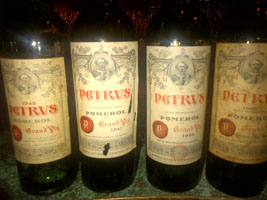
Legends of the Fall
Our Hamptons auction was right after this event, and while I’m not even sure I have ever been drunk walking into an auction, (I usually do my best drinking at the auction itself), I can safely say that I have never been more drunk walking into an auction than for this one lol. I didn’t exactly hammer down as much as usual that night, but thankfully Truly and Samantha picked up the slack. There are many great Bordeaux, but I have to say that Chateau Petrus is the fairest of them all. In today’s retail market, price is not always an indicator of quality, but in the auction market, it is, and there is a reason that Petrus is consistently Bordeaux’s most expensive wine. Long live Chateau Petrus.
In Vino Veritas,
JK
